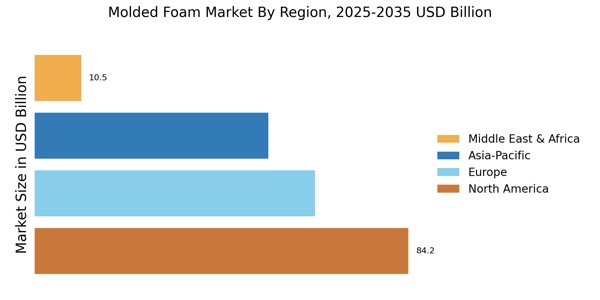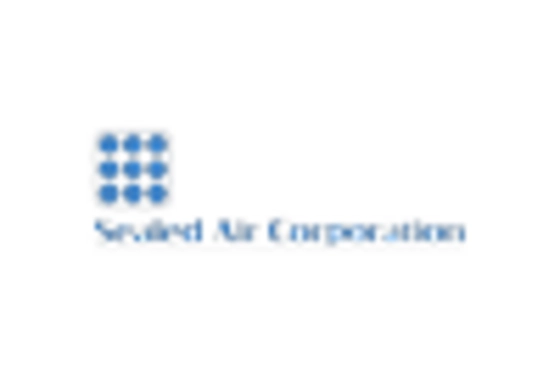Growth in Consumer Electronics
The Molded Foam Market is significantly influenced by the burgeoning consumer electronics sector. With the increasing proliferation of electronic devices, the demand for protective packaging solutions has escalated. Molded foam is widely recognized for its ability to provide cushioning and protection for fragile electronic components during transportation and storage. Market data indicates that the consumer electronics segment is expected to witness a compound annual growth rate of around 6% over the next few years. This growth is attributed to the rising consumer preference for high-quality packaging that ensures product safety. Additionally, as manufacturers strive to enhance the unboxing experience, molded foam packaging solutions are becoming increasingly popular. Therefore, the molded foam market stands to gain from the ongoing advancements in consumer electronics, which necessitate innovative and effective packaging solutions.
Rising Demand in Automotive Sector
The Molded Foam Market experiences a notable surge in demand driven by the automotive sector. As manufacturers increasingly prioritize lightweight materials to enhance fuel efficiency, molded foam serves as an ideal solution. The automotive industry is projected to account for a substantial share of the molded foam market, with estimates suggesting a growth rate of approximately 5% annually. This trend is further supported by the need for improved comfort and safety features in vehicles, where molded foam is utilized in seating, insulation, and soundproofing applications. Consequently, the molded foam market is likely to benefit from the ongoing innovations in automotive design and manufacturing processes, which emphasize the integration of advanced materials. As a result, the molded foam market is poised for significant expansion, reflecting the automotive sector's evolving requirements.
Expansion in Healthcare Applications
The Molded Foam Market is experiencing notable growth due to its expanding applications in the healthcare sector. Molded foam is increasingly utilized in medical devices, patient support products, and protective packaging for pharmaceuticals. The healthcare industry is projected to grow at a compound annual growth rate of approximately 5% in the coming years, driven by the rising demand for comfortable and supportive medical products. Additionally, molded foam's properties, such as its ability to conform to body shapes and provide pressure relief, make it an ideal choice for various healthcare applications. As the healthcare sector continues to innovate and expand, the molded foam market is likely to benefit from increased investments in medical technology and the development of new healthcare products that require specialized foam solutions.
Increased Focus on Sustainable Materials
The Molded Foam Market is witnessing a paradigm shift towards sustainability, as consumers and manufacturers alike prioritize eco-friendly materials. The growing awareness of environmental issues has prompted companies to seek alternatives to traditional foam products, leading to the development of biodegradable and recyclable molded foam options. Market analysis suggests that the demand for sustainable molded foam solutions is likely to increase, with projections indicating a potential market growth of 4% annually. This trend is further fueled by regulatory pressures and consumer preferences for sustainable packaging and products. As a result, manufacturers in the molded foam market are investing in research and development to create innovative, environmentally friendly solutions that meet these evolving demands. This focus on sustainability not only enhances brand reputation but also aligns with the broader movement towards responsible consumption.
Technological Innovations in Manufacturing
The Molded Foam Market is significantly impacted by ongoing technological innovations in manufacturing processes. Advances in production techniques, such as improved molding technologies and automation, are enhancing the efficiency and quality of molded foam products. These innovations are expected to drive down production costs while simultaneously improving product performance. Market data indicates that the adoption of advanced manufacturing technologies could lead to a potential increase in market share for molded foam products by approximately 7% over the next few years. Furthermore, the integration of smart technologies into molded foam applications, such as temperature-sensitive materials, is likely to create new opportunities within the market. As manufacturers continue to embrace these technological advancements, the molded foam market is poised for substantial growth, reflecting the evolving landscape of manufacturing.


















Leave a Comment